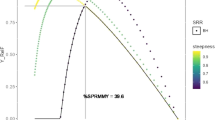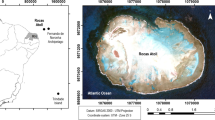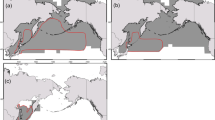Abstract
In the East China Sea (ECS), chub mackerel Scomber japonicus constitutes an important coastal-pelagic fishery resource that is mainly exploited by Chinese, Japanese, and Korean light-purse seine fisheries. Because the early life history of chub mackerel plays a significant role in its recruitment, we developed an individual-based model to study the distribution, growth, and survival rate of chub mackerel larvae and juveniles in the ECS to improve our understanding of the chub mackerel population structure and recruitment. Our results show that as body length rapidly increases, the swimming capacity of chub mackerel larvae and juveniles improves quickly, and their spatial distribution depends more on their habitat conditions than the ocean currents. Correspondingly, the juveniles from the central and southern ECS spawning ground are scarcely recruited into the Japan/East Sea (JES) or the western Pacific Ocean, but a significant proportion of juveniles from the northern ECS spawning ground still enter the JES and there are exchanges between the stocks in the ECS and JES. Thus, it seems more reasonable to assess and manage the chub mackerels in the ECS and JES as a stock. The water temperature and ocean primary production in the ECS are two important factors influencing the chub mackerel habitat conditions and their spatial and temporal distribution are significantly different as the spawning time changes. Therefore, the spawning time and location play an important role in the growth and survival rate of the larvae and juveniles. Generally, when chub mackerel spawns at the southern ECS spawning ground in March, the larva and juvenile growth and survival rate is relatively high; as spawning time moves forward, higher growth and survival rates would be expected for the chub mackerel spawned coastward or northward. For specific spawning sites, early or delayed spawning will reduce the survival rate.
Similar content being viewed by others
Data Availability Statement
The datasets generated and analyzed during the current study are available from the corresponding author on reasonable request.
References
Bartsch J, Coombs S H. 2004. An individual-based model of the early life history of mackerel (Scomber scombrus) in the eastern North Atlantic, simulating transport, growth and mortality. Fisheries Oceanography, 13(6): 365–379, https://doi.org/10.1111/j.1365-2419.2004.00305.x.
Carvalho N, Perrotta R G, Isidro E. 2002. Age, growth and maturity in the chub mackerel (Scomber japonicus Houttuyn, 1782) from the Azores. Life and Marine Sciences, 19A: 93–99.
Chen C, Beardsley R C, Cowles G et al. 2013. An unstructured grid, finite-volume community ocean model FVCOM user manual. SMAST/UMASSD-13-0701. https://github.com/FVCOM-GitHub/fvcom43/blob/master/Doc/FVCOM_User_Manual_v3.1.6.pdf. Accessed on 2023-01-28.
Cheng J H, Lin L S. 2004. Study on the biological characteristics and status of common mackerel (Scomber japonicus Houttuyn) fishery in the East China Sea region. Marine Fisheries, 26(2): 73–78, https://doi.org/10.3969/j.issn.1004-2490.2004.02.001. (in Chinese with English abstract)
Collette B B, Nauen C. 1983. FAO Species Catalogue Vol. 2. Scombrids of the World. An Annotated and Illustrated Catalogue of Tunas, Mackerels, Bonitos and Related Species Known to Data. FAO, Rome.
Cowen R K, Paris C B, Srinivasan A. 2006. Scaling of connectivity in marine populations. Science, 311(5760): 522–527, https://doi.org/10.1126/science.1122039.
Duboz R, Versmisse D, Travers M et al. 2010. Application of an evolutionary algorithm to the inverse parameter estimation of an individual-based model. Ecological Modelling, 221(5): 840–849, https://doi.org/10.1016/j.ecolmodel.2009.11.023.
Epur I V. 2009. Ecological and zoogeographic characterization of the ichthyofauna of Sivuch’ya Bay (Peter the Great Bay, Sea of Japan). Russian Journal of Marine Biology, 35(2): 117–126, https://doi.org/10.1134/S1063074009020023.
Faugeras B, Maury O. 2007. Modeling fish population movements: from an individual-based representation to an advection-diffusion equation. Journal of Theoretical Biology, 247(4): 837–848, https://doi.org/10.1016/j.jtbi.2007.04.012.
Gislason H, Daan N, Rice J C et al. 2010. Size, growth, temperature and the natural mortality of marine fish. Fish and Fisheries, 11(2): 149–158, https://doi.org/10.1111/j.1467-2979.2009.00350.x.
Go S, Lee K, Jung S. 2020. A temperature-dependent growth equation for larval chub mackerel (Scomber japonicus). Ocean Science Journal, 55(1): 157–164, https://doi.org/10.1007/s12601-020-0004-z.
Gregg W W, Carder K L. 1990. A simple spectral solar irradiance model for cloudless maritime atmospheres. Limnology and Oceanography, 35(8): 1657–1675, https://doi.org/10.4319/lo.1990.35.8.1657.
Guan W J. 2008. Remote-sensing-based Assessment of Chub Mackerel (Scomber japonicus) Fishing Ground and Stock Dynamics in the East China Sea and Yellow Sea. East China Normal University, Shanghai. (in Chinese with English abstract)
Guan W J, Chen X J, Li G. 2011. Influence of sea surface temperature and La Niña event on temporal and spatial fluctuation of chub mackerel (Scomber japonicus) stock in the East China Sea. Journal of Shanghai Ocean University, 20(1): 102–107. (in Chinese with English abstract)
Guan W J, Gao F, Li G et al. 2014. Risk evaluation for metapopulation management: a case study using chub mackerel. Acta Ecologica Sinica, 34(13): 3682–3692, https://doi.org/10.5846/stxb201211121588. (in Chinese with English abstract)
Guan W J, He X Q, Pan D L et al. 2005. Estimation of ocean primary production by remote sensing in Bohai Sea, Yellow Sea and East China Sea. Journal of Fisheries of China, 29(3): 367–372, https://doi.org/10.3321/j.issn:1000-0615.2005.03.015. (in Chinese with English abstract)
Guan W J, Ma X L. 2022. Assessment of the status of Scomber japonicus resource in the East China Sea and Yellow Sea using a Bayesian biomass dynamic model. Journal of Shanghai Ocean University, 31(3): 749–760, https://doi.org/10.12024/jsou.20220103672. (in Chinese with English abstract)
Guo C Y, Ito S I, Wegner N C et al. 2020. Metabolic measurements and parameter estimations for bioenergetics modelling of Pacific Chub Mackerel Scomber japonicus. Fisheries Oceanography, 29(3): 215–226, https://doi.org/10.1111/fog.12465.
Hemelrijk C K, Kunz H. 2004. Density distribution and size sorting in fish schools: an individual-based model. Behavioral Ecology, 16(1): 178–187, https://doi.org/10.1093/beheco/arh149.
Hilborn R, Walters C J. 1992. Quantitative Fisheries Stock Assessment: Choice, Dynamics and Uncertainty. Chapman and Hall, London. 570p, https://doi.org/10.1007/978-1-4615-3598-0.
Hiyama Y, Yoda M, Ohshimo S. 2002. Stock size fluctuations in chub mackerel (Scomber japonicus) in the East China Sea and the Japan/East Sea. Fisheries Oceanography, 11(6): 347–353, https://doi.org/10.1046/j.1365-2419.2002.00217.x.
Hunter J R, Kimbrell C A. 1980. Early life history of Pacific mackerel, Scomber japonicus. Fishery Bulletin, 78(1): 89–100.
Hwang S D. 1999. Population Ecology of Pacific Mackerel, Scomber japonicus, off Korea. Chungnam National University, Daejeon. (in Korean)
Hwang S D, Lee T W. 2005. Spawning dates and early growth of chub mackerel Scomber japonicus as indicated by otolith microstructure of juveniles in the inshore nursery ground. Fisheries Science, 71(5): 1185–1187, https://doi.org/10.1111/j.1444-2906.2005.01081.x.
Kieffer H H, Stone T C. 2005. The spectral irradiance of the Moon. The Astronomical Journal, 129(6): 2887–2901, https://doi.org/10.1086/430185.
Lehodey P, Senina I, Murtugudde R. 2008. A spatial ecosystem and populations dynamics model (SEAPODYM)-Modeling of tuna and tuna-like populations. Progress in Oceanography, 78(4): 304–318, https://doi.org/10.1016/j.pocean.2008.06.004.
Li Y S. 2012. Simulation Study of Ecosystem Dynamics of Early Life History of Chub Mackerel (Scomber japonicus) in the East China Sea. Shanghai Ocean University, Shanghai. (in Chinese with English abstract)
Li Y S, Chen X J, Chen C S et al. 2014. Dispersal and survival of chub mackerel (Scomber Japonicus) larvae in the East China Sea. Ecological Modelling, 283: 70–84, https://doi.org/10.1016/j.ecolmodel.2014.03.016.
Li Y S, Pan L Z, Guan W J et al. 2018. Simulation study of individual-based model on interannual fluctuation of Chub mackerel’s (Scomber japonicus) recruitment in the East China Sea. Haiyang Xuebao, 40(1): 87–95. (in Chinese with English abstract)
Liu Y, Yan L P, Hu F et al. 2005. Age and growth of Pneumatophorus japonicus in the North of the East China Sea and the South of the Yellow Sea. Marine Fisheries, 27(2): 133–138, https://doi.org/10.3969/j.issn.1004-2490.2005.02.008. (in Chinese with English abstract)
Mendiola D, Yamashita Y, Matsuyama M et al. 2009. Estimation of the daily food intake and gross growth efficiency of chub mackerel (Scomber japonicus) larvae under various temperatures. Aquaculture Science, 57(2): 291–299, https://doi.org/10.11233/aquaculturesci.57.291.
Miao Z Q. 1993. Relation between Pneumatophorus and Carangidae fishing grounds in the summer-autumn and ocean hydrologic environment in the northern part of the East China Sea. Journal of Zhejiang College of Fisheries, 12(1): 32–39. (in Chinese with English abstract)
Miller B S, Kendall A W Jr. 2009. Early Life History of Marine Fishes. University of California Press, California. 359p.
Miller T J. 2007. Contribution of individual-based coupled physical-biological models to understanding recruitment in marine fish populations. Marine Ecology Progress Series, 347: 127–138, https://doi.org/10.3354/meps06973.
National Research Institute of Fisheries Science and Saikai National Fisheries Research Institute. 2019. Stock assessment of Chub Mackerel Tsushima stock (2019). https://www.fra.affrc.go.jp/shigen_hyoka/peer_review/2019/assess_masaba_T.pdf. Accessed on 2023-01-28.
Nikolic N, Montes I, Lalire M et al. 2020. Connectivity and population structure of albacore tuna across southeast Atlantic and southwest Indian Oceans inferred from multidisciplinary methodology. Scientific Reports, 10(1): 15657, https://doi.org/10.1038/s41598-020-72369-w.
Nishida H. 1997. Long term fluctuations in the stock of jack mackerel and chub mackerel in the western part of Japan Sea. Bulletin of the Fish Society of Japan Fisheries Oceanography, 61: 316–318. (in Japanese)
Pepin P. 1991. Effect of temperature and size on development, mortality, and survival rates of the pelagic early life history stages of marine fish. Canadian Journal of Fisheries and Aquatic Sciences, 48(3): 503–518, https://doi.org/10.1139/f91-065.
Phillips J S, Gupta A S, Senina I et al. 2018. An individual-based model of skipjack tuna (Katsuwonus pelamis) movement in the tropical Pacific Ocean. Progress in Oceanography, 164: 63–74, https://doi.org/10.1016/j.pocean.2018.04.007.
Pikitch E K, Santora C, Babcock E A et al. 2004. Ecosystem-based fishery management. Science, 305(5682): 346–347, https://doi.org/10.1126/science.1098222.
Revell S J, Hignett P. 2004. MONIM: the new met office night illumination model. Meteorological Applications, 11(3): 221–229, https://doi.org/10.1017/S1350482704001276.
Richards S A, Possingham H P, Noye J. 1996. Diel vertical migration: modelling light-mediated mechanisms. Journal of Plankton Research, 18(12): 2199–2222, https://doi.org/10.1093/plankt/18.12.2199.
Ross O N, Sharples J. 2004. Recipe for 1-D Lagrangian particle tracking models in space-varying diffusivity. Limnology and Oceanography Methods, 2(9): 289–302, https://doi.org/10.4319/lom.2004.2.289.
Sassa C, Tsukamoto Y. 2010. Distribution and growth of Scomber japonicus and S. australasicus larvae in the southern East China Sea in response to oceanographic conditions. Marine Ecology Progress Series, 419: 185–199, https://doi.org/10.3354/meps08832.
Senina I N, Lehodey P, Hampton J et al. 2020. Quantitative modelling of the spatial dynamics of South Pacific and Atlantic albacore tuna populations. Deep-Sea Research Part II: Topical Studies in Oceanography, 175: 104667, https://doi.org/10.1016/j.dsr2.2019.104667.
Shelekhov V A, Epur I V, Balanov A A. 2020. Species composition and structure of ichthyoplankton of the northern part of the Sea of Japan in Summer of 2017. Journal of Ichthyology, 60(1): 36–47, https://doi.org/10.1134/S0032945220010154.
Shin Y J, Cury P. 2004. Using an individual-based model of fish assemblages to study the response of size spectra to changes in fishing. Canadian Journal of Fisheries and Aquatic Sciences, 61(3): 414–431, https://doi.org/10.1139/f03-154.
Shiraishi T, Okamoto K, Yoneda M et al. 2008. Age validation, growth and annual reproductive cycle of chub mackerel Scomber japonicus off the waters of northern Kyushu and in the East China Sea. Fisheries Science, 74(5): 947–954, https://doi.org/10.1111/j.1444-2906.2008.01612.x.
Taga M, Kamimura Y, Yamashita Y. 2019. Effects of water temperature and prey density on recent growth of chub mackerel Scomber japonicus larvae and juveniles along the Pacific coast of Boso-Kashimanada. Fisheries Science, 85(6): 931–942, https://doi.org/10.1007/s12562-019-01354-8.
Visser A W. 1997. Using random walk models to simulate the vertical distribution of particles in a turbulent water column. Marine Ecology Progress Series, 158: 275–281, https://doi.org/10.3354/meps158275.
Wang L M, Ma S Y, Liu Y et al. 2021. Fluctuations in the abundance of chub mackerel in relation to climatic/oceanic regime shifts in the Northwest Pacific Ocean since the 1970s. Journal of Marine Systems, 218: 103541, https://doi.org/10.1016/j.jmarsys.2021.103541.
Wang Y B, Zheng J, Yu C G. 2014. Stock assessment of chub mackerel (Scomber japonicus) in the central East China Sea based on length data. Journal of the Marine Biological Association of the United Kingdom, 94(1): 211–217, https://doi.org/10.1017/S0025315413001434.
Yamashita Y, Tanaka M, Miller J M. 2001. Ecophysiology of juvenile flatfish in nursery grounds. Journal of Sea Research, 45(3–4): 205–218, https://doi.org/10.1016/S1385-1101(01)00049-1.
Yan L P, Zhang H, Li S F et al. 2012. Progress of population identification and classification of chub mackerel (Scomber japonicus) in the East China Sea and the Yellow Sea. Marine Fisheries, 34(2): 217–221, https://doi.org/10.3969/j.issn.1004-2490.2012.02.015. (in Chinese with English abstract)
Yasuda T, Nagano N, Kitano H. 2018. Diel vertical migration of chub mackerel: preliminary evidence from a biologging study. Marine Ecology Progress Series, 598: 147–151, https://doi.org/10.3354/meps12636.
Yasuda T, Yukami R, Ohshimo S. 2014. Fishing ground hotspots reveal long-term variation in chub mackerel Scomber japonicus habitat in the East China Sea. Marine Ecology Progress Series, 501: 239–250, https://doi.org/10.3354/meps10679.
Yukami R, Ohshimo S, Yoda M et al. 2009. Estimation of the spawning grounds of chub mackerel Scomber japonicus and spotted mackerel Scomber australasicus in the East China Sea based on catch statistics and biometric data. Fisheries Science, 75(1): 167–174, https://doi.org/10.1007/s12562-008-0015-7.
Zheng Y J, Chen X Z, Cheng J H et al. 2003. Biological resources and environment on the continental shelf of the East China Sea. Shanghai Scientific and Technical Publishers, Shanghai, China. 834p. (in Chinese)
Zhu W B, Cui G C, Hu C L et al. 2021. Effects of environmental factors on growth and distribution of young chub mackerel Scomber japonicus along the coast of Zhejiang in spring. Oceanologia et Limnologia Sinica, 52(6): 1448–1455, https://doi.org/10.11693/hyhz20210500117. (in Chinese with English abstract)
Acknowledgment
We are grateful to Professor Changsheng CHEN from University of Massachusetts Dartmouth for assistance in the development of the IBM and we also thank Dr. Yu ZHANG and Dr. Yuesong LI from Shanghai Ocean University for their help in the data process.
Author information
Authors and Affiliations
Corresponding author
Additional information
Supported by the National Natural Science Foundation of China (No. 32072981)
Rights and permissions
About this article
Cite this article
Guan, W., Ma, X., He, W. et al. Simulation of the distribution, growth, and survival rate of chub mackerel larvae and juveniles in the East China Sea. J. Ocean. Limnol. 41, 1602–1619 (2023). https://doi.org/10.1007/s00343-022-2012-6
Received:
Accepted:
Published:
Issue Date:
DOI: https://doi.org/10.1007/s00343-022-2012-6




